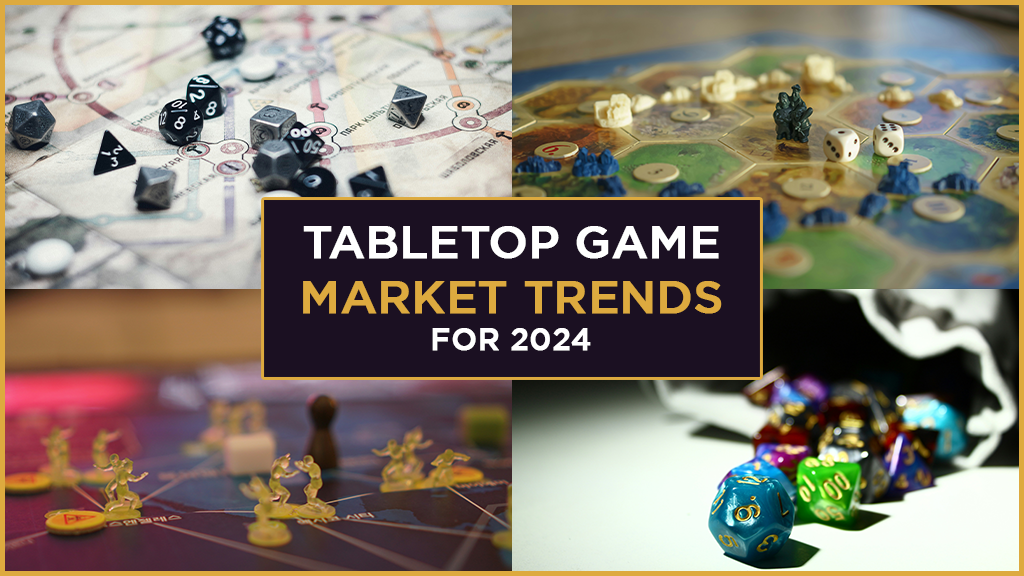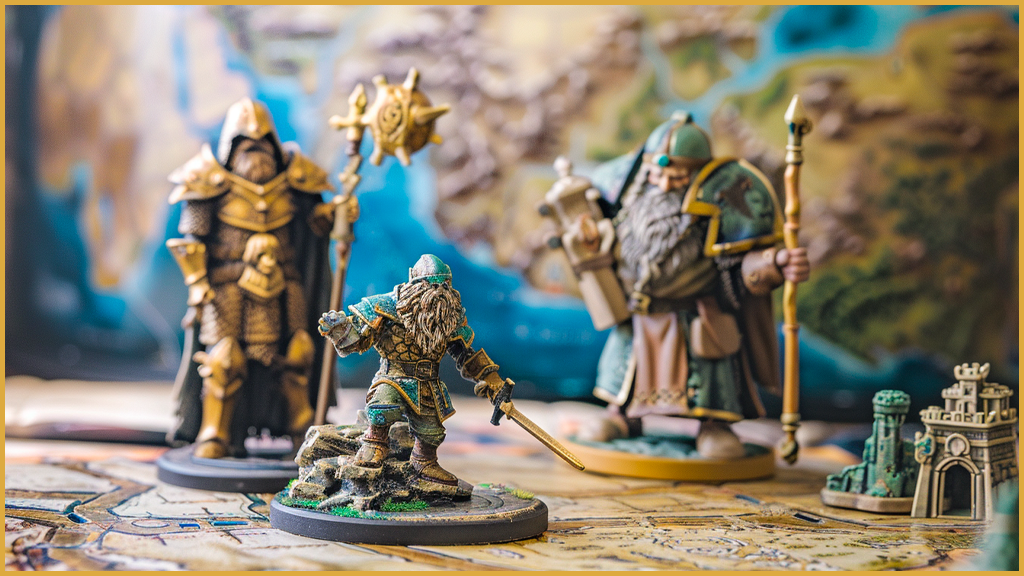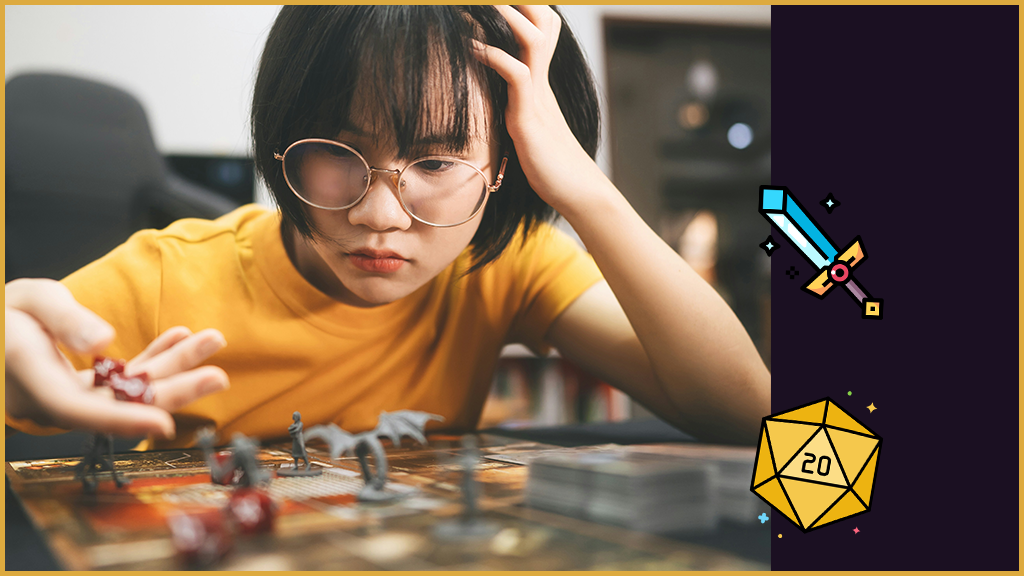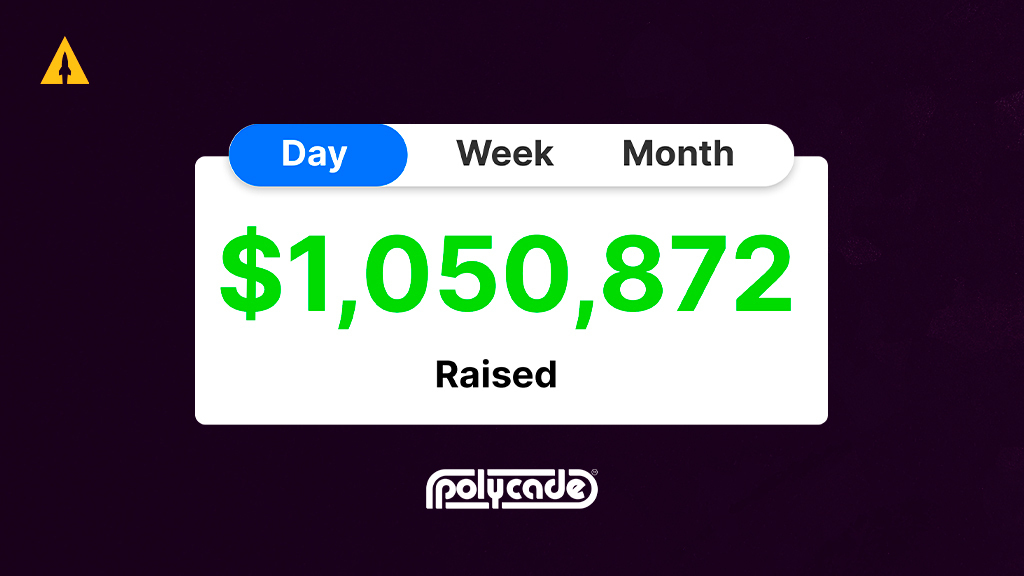
Games are shaking up the consumer market. The global board game market is projected to grow from $13.6 billion in 2023 to $26 billion by 2030.
As crowdfunding experts, we keep a close watch for new developments in gaming. Games are the top category on Kickstarter and account for 31% of successful Kickstarter funding. And at LaunchBoom Games, we’ve had our hand in exciting game releases, including The Crooked Moon, Kelp, and Botany.
Needless to say, we know a thing or two about gaming trends before they hit the mass market. If you want to make a splash in tabletop gaming this year, here’s what you need to know.
- Evolution of the tabletop games market
- Market size of tabletop games
- Major players and their market share
- Current key challenges in tabletop games
- Tabletop games market trends (in 2024)
Contents
Evolution of the tabletop games market

Initially, classics like Scrabble and Monopoly dominated the industry. Fun fact, POW camps in World War II Germany allowed prisoners to play Monopoly. To help prisoners escape, the British Secret Service smuggled escape gear into the game boxes and slipped real banknotes among the fake money. Over 35,000 Allied soldiers successfully escaped — it was basically a real-life Get Out of Jail Free card!
In the 1970s, the rise of role-playing games (RPGs) like Dungeons & Dragons introduced new game elements like collaborative storytelling, improvisation, and character development.
In the 1990s, collectible card games (CCGs) like Magic: The Gathering came with strategic gameplay and intricate card mechanics. Eurogames like Settlers of Catan brought greater complexity to resource management strategy.
Today, there are over 150,000 titles on BoardGameGeek in genres from adventure to science fiction to fantasy to war games. Creators have tons of mechanics at their disposal from auctioning to deck building to role-playing. But the most notable evolution is this: along the way, board games transformed from a niche, “nerd” hobby to a global, mainstream phenomenon.
The rebirth of the tabletop games market
In 2020, the world went on lockdown. People couldn’t go to movie theaters, restaurants, shopping malls, or concerts. How could families or roommates confined at home keep themselves entertained? Quickly, a solution emerged: board games.
Board game sales soared. Hasbro’s gaming revenue totaled $1.76 billion in 2020, up 15% from 2019. And a whole bunch of people who never showed interest prior to 2020 started exploring tabletops for the first time.
Google Trends data reveals that in the U.K.:
- Search interest for “Warhammer” increased 49% since 2020
- Search interest for “DnD” increased 85% since 2020
And it looks like that popularity is here to stay:
- Games Workshop Group ended their 2023 fiscal at $470.80 million, a 74.6% increase since 2020
- Magic: The Gathering made $1 billion in 2023, accounting for over half of Hasbro’s total earnings
- Over 50 million worldwide people play Dungeons & Dragons
It’s clear, we’re living through the rebirth of the tabletop games market. It’s never been more exciting to be a tabletop player and creator.

The current size of the tabletop games market
In 2022, the global tabletop games market size was valued at $11.88 billion. It’s projected to reach $26.04 billion by 2030, exhibiting a CAGR of 10.36%. Let’s dive into the state of the board game market today.
How popular is tabletop gaming?
People all over the world appreciate tabletop gaming.
- 38% of Gen Z in the U.S. enjoy playing board games
- 34% of U.S. consumers find playing board games very enjoyable and 44% of U.S. consumers consider playing board games somewhat enjoyable
- 57% of gamers own between 1 and 25 board and card games, while 22% own between 26 and 50
And there are thriving communities dedicated to board game discussion and culture:
- BoardGameGeek receives over 19 million monthly visitors
- BoardGameGeek has over 100,000 game-specific forums
- Reddit’s r/boardgames has over 4.4 million members
Is there a demand for board games?
Not only is there a growing demand for board games, there’s also a growing diversity of board game genres and board game enjoyers. Board games are appealing to more people than they ever have before. There are a number of key factors driving the demand:
- Portrayal of games in TV and media. The Queen’s Gambit contributed to a 87% spike in chess set sales and a 603% in chess books. Stranger Things inspired a 600% increase to the Google search query “how to play Dungeons and Dragons.”
- Diversity in themes. Consumer preferences are steering towards diverse and immersive themes. From World War II history to deep space science fiction to idyllic bird keeping, you’ll find demand for every niche interest and genre.
- Age and gender inclusivity. The age-old stereotypes about gamers are becoming less and less true. 51% of board game players are female. 38% of Gen Z, 38% of Millennials, 34% of Gen X, and 29% of Baby Boomers reported being very fond of board games. And 27.9% of board game players have a high school diploma as the highest level of educational attainment.
Analysis factors
We can also look at where and how consumers play board games. Tabletop games market research shows that:
- 40% of gamers play at home, 33% play at game stores, and 25% play at restaurants.
- 59.3% gamers buy their games through Amazon, 41% buy on Kickstarter, and 88.44% buy from their local game store.
- 43% of gamers report playing a few times a week, 25% say once a week, and 17% say twice a month
Recent research findings
Another recent finding suggests that board games improve math ability in young children. In a comprehensive review of 19 different studies exploring the relationship between board games and mathematical and numerical skills:
- In 52% of the reported tasks, math skills improved significantly in children who participated in board game intervention sessions
- In 32% of cases, children in the intervention groups gained better results than those in the control groups
These findings have implications on the way we teach and introduce board games to future generations. And it can affect the way we create, produce, and market games down the road.
Major players in the tabletop games market

There are over 20,000 board game publishers in the market. These are the major players on the scene:
- Asmodee Group: The distributor of Catan, Ticket to Ride, and Carcassonne, Asmodee has become a powerhouse through multiple strategic acquisitions like Fantasy Flight Games (FFG), Z-Man Games, and Days of Wonder. Asmodee is the market leader, accounting for 18% of the global tabletop market share.
- Hasbro: Known for classics like Monopoly, Scrabble, and Risk, Hasbro has long been an industry front-runner. They also acquired Wizards of the Coast, responsible for Magic: The Gathering and Dungeons & Dragons. They account for 12% of the global tabletop market share.
- Ravensburger: A German company known for high-quality board games, Ravensburger produces a range of family-friendly titles like Labyrinth and Memory. Their games often combine engaging gameplay with educational elements. They account for 4% of the global tabletop market share.
- Thames and Kosmos: Known for board games like Ubongo and Lost Cities, as well as its educational science and craft kits, Thames and Kosmos accounts for 2% of the global tabletop market share.
- Mattel: Famous for UNO, Othello, and Pictionary, Mattel has a diverse portfolio of games suitable for various age groups.
- Buffalo Games: With hits like Watch Ya’ Mouth and Skee-Ball, Buffalo Games owns the party games space. They are also a licensing giant, with products featuring Disney, Star Wars, Pokémon, Star Trek, and Game of Thrones characters.
- Stonemaier Games: While not as large as the others, Stonemaier Games gained widespread recognition with Scythe, Tapestry, and Wingspan.
Key challenges in the tabletop games market
Despite its upward trajectory, the tabletop market is fraught with its fair share of roadblocks too. As more and more players enter the market, we’ll see increased issues surrounding:
- Intellectual property and licensing. As a new creator, you’re entering a complex jungle of trademarks, licenses, and franchises.
- Market saturation. Yes, there’s a demand for games. But there’s also a ton of competition. 5,000 new games come out every year. On Kickstarter, 3,000 campaigns are clamoring for attention on any given day.
- Art costs. Commissioning art for your game can be very expensive. And although you can use AI art, the board game community has shown some disdain for this.
- Supply chain disruptions. Fluctuations in material costs, labor, and shipping expenses make it hard to predict go-to-market costs. And because much of game manufacturing is overseas, international supply chain issues can hugely delay production and shipping.
Tabletop games market trends for 2024
We know the state of the market today. But where is it all headed? The tabletop gaming market is constantly evolving, and it’s important for creators to stay on top of the industry. Here are the top trends to look out for in 2024:
- Educational standards
- Sustainable and eco-friendly practices
- Family and social bonding
- Rise in millennial gamers
- Technological integration
- Diversity and inclusion
- Crowdfunding
- Global market expansion

Educational standards
Board games are jam-packed with educational application, from resource management to critical thinking to probability to problem-solving.
Gamification is already big in digital learning. Programs like Duolingo or Math 180 use achievement unlocks to motivate learners. Minecraft Education teaches reading, math, history, and coding through play. And in the tabletop industry, Ravensburger and Kosmos occupy a sizable market share through their educational, family-friendly games.
In 2024, more parents and educators will look for ways to incorporate gameplay into classroom learning. We anticipate more partnerships between game developers and educational institutions and more educational tabletops hitting the market.
Sustainable and eco-friendly practices
Not only do consumers want games that are fun, they also want to make environmentally-conscious choices and feel good about their purchases. In 2024, we’ll see a greater emphasis on recycled materials, eco-friendly production, and sustainable packaging.
Jenga partnered with Bureo to release Jenga Ocean, the first board game made from 100% recycled fishing nets. Stonemaier Games announced that they now use all FSC-certified materials, ensuring their wood is harvested in a way that allows the trees to grow back. In Wingspan, they also replaced their plastic trays and containers with recyclable materials and their plastic eggs with wooden ones.
If your game has nature themes, sustainability should definitely be part of your marketing strategy. Our client Wonderbow Games committed to using sustainable materials, using high-quality, long-lasting components, and partnering with environmentally-friendly factories. Their campaign for Kelp raised €1,429,286 on Kickstarter.
Family and social bonding
As screens permeate daily life, we’ll see more families and friend groups using board games as a digital detox. In 2024, consumers want games that bridge generational gaps, build community, and act as the glue for social gatherings, reunions, and parties.
Young millennial populations
Millennials are the “Experience Generation.” Consumer research has shown that millennials put more value in experiences over material things. Games appeal to Millennials because they offer meaningful face-to-face interactions, collaborative storytelling, and a multitude of laughs and memories.
Plus, Millennials enjoy nostalgia. Another reason why Dungeons & Dragons and Magic: The Gathering are making a comeback is because Millennials are rediscovering the classics from the 80s and 90s. In 2024, think about how your story, gameplay, and design might create memorable experiences and evoke childhood nostalgia.
Technological integration
Yes, a huge appeal of board games is being social and face-to-face. However, we can’t deny that technology is making its way onto the scene. Technological integrations through augmented reality (AR), virtual reality (VR), and app-assisted games blend traditional tabletop gaming with modern technology.
Catan announced its partnership with Tilt Five, an AR entertainment company, to create a 3D holographic game experience. Dune: Imperium comes with an official companion app to assist with setup and solo play. Demeo, released on the Oculus Quest and Playstation VR2, uses VR to recreate the magic and camaraderie of gathering around the table to fight monsters.
In 2024, expect to see hybrid game experiences push the boundaries of what tabletops can look, feel, and sound like.
Diversity and inclusion
“You are more likely to see a sheep on the cover of a board game box than you are to see a group of women. No, seriously.”
This was Erin Ryan’s conclusion after gathering the top 20 games each year from 2009 to 2016. She found that 62.6% of games only featured men on the cover, 18.7% had mixed groups primarily featuring men, 7.9% had mixed groups with an equal number of men and women, and 5% only featured women. Meanwhile, 7.5% of games featured sheep.
There’s long been an overrepresentation of able-bodied, white, cis-gendered men in board games. But recently, more creators are acknowledging that this isn’t accurately representing the people who enjoy their games.
Games like Healthy Heart Hospital, Sleeping Gods, and Legacy of Dragonholt have amazing gender representation. Spirit Island has blatantly anti-colonialist themes. In 2024, pay attention to how creators are making their cover art, characters, settings, and themes more diverse and inclusive.
Crowdfunding
If you’re thinking of launching a new game, crowdfunding is definitely worth considering. Crowdfunding and gaming have traditionally gone hand in hand; if you’ve played Exploding Kittens, Cards Against Humanity, Unstable Unicorns, Joking Hazard, or Throw Throw Burrito (the list goes on!), you’ve played a crowdfunded game.
Games is the most funded category on Kickstarter. There have been 41,279 successful gaming projects on Kickstarter, raising $2.39 billion in pledge revenue. And in 2023, Gamefound had a record year, raising over $56 million for new tabletop creators.
As official Kickstarter experts, we help game creators leverage the power of crowdfunding:
- We got Ascendancy fully funded in 10 minutes
- We raised €1,429,284 for Kelp
- We raised $4,020,234 for The Crooked Moon, now the most funded 5e campaign ever on Kickstarter
In 2024, it’s time to stop sitting on your dreams. If you have a game concept you’re itching to bring to life, talk to a crowdfunding expert today.
Global market expansion
Tabletops are expanding globally. Although North America historically dominates the global market share, Europe and Asia Pacific are rapidly gaining. In Europe, Germany is especially emerging as an industry leader.
In 2024, look out for more game releases outside the U.S. Expect to see international, cross-cultural collaboration between developers, playtesters, and designers. And with more global creators, be excited for a greater diversity of cultural themes, mythologies, and historical events in games.
Final thoughts
Tabletop gaming is a billion-dollar industry. From Monopoly in the 1930s to DnD in the 1970s to the hundreds of thousands of titles available today — board gaming has always held a grip on our culture and community. As we head further into 2024, let’s keep an eye out for:
- Educational standards and concepts in tabletop gaming
- Sustainable and eco-friendly practices
- The role of tabletops in family and social bonding
- Buying behaviors of Millennial consumers
- AR, VR, and app integrations in tabletop games
- Diversity and inclusion in tabletop storytelling, character design, and artwork
- The role of crowdfunding in new game development
- Global expansion of the tabletop industry
Tabletop games market trends: Frequently asked questions
How big is the tabletop games market?
In 2022, the global tabletop games market size was valued at $11.88 billion.
What are the top players operating in the tabletop games market?
The top players operating in the tabletop games market are:
- Asmodee Group, known for Catan, Ticket to Ride, and Carcassonne
- Hasbro, known for Monopoly, Scrabble, and Risk and subsidiary Wizards of the Coast, responsible for Dungeons & Dragons and Magic: The Gathering
- Ravensburger, known for Labyrinth and Memory
- Thames and Kosmos, known for board games like Ubongo and Lost Cities
- Mattel, known for UNO, Othello, and Pictionary
- Buffalo Games, known for Watch Ya’ Mouth and Skee-Ball
- Stonemaier Games, known for Scythe, Tapestry, and Wingspan
How significant is crowdfunding for the tabletop games industry?
Crowdfunding is one of the best platforms for emerging game designers to gain recognition and support. Some of the hottest games on the market got their start on Kickstarter, including Gloomhaven, Scythe, Nemesis Lockdown, and Avatar Legends.
Is the tabletop games market expanding globally?
The global tabletop games market is projected to reach $26.04 billion by 2030, exhibiting a CAGR of 10.36%. It’s particularly expected to grow in Europe and Asia Pacific.




